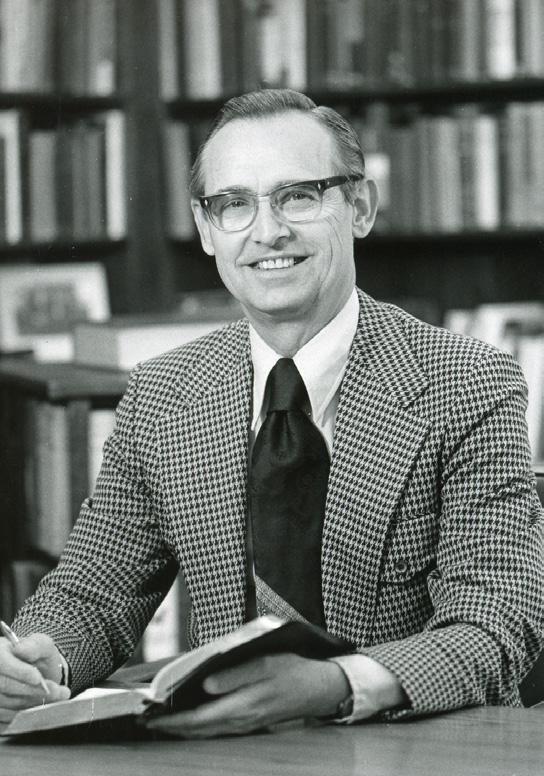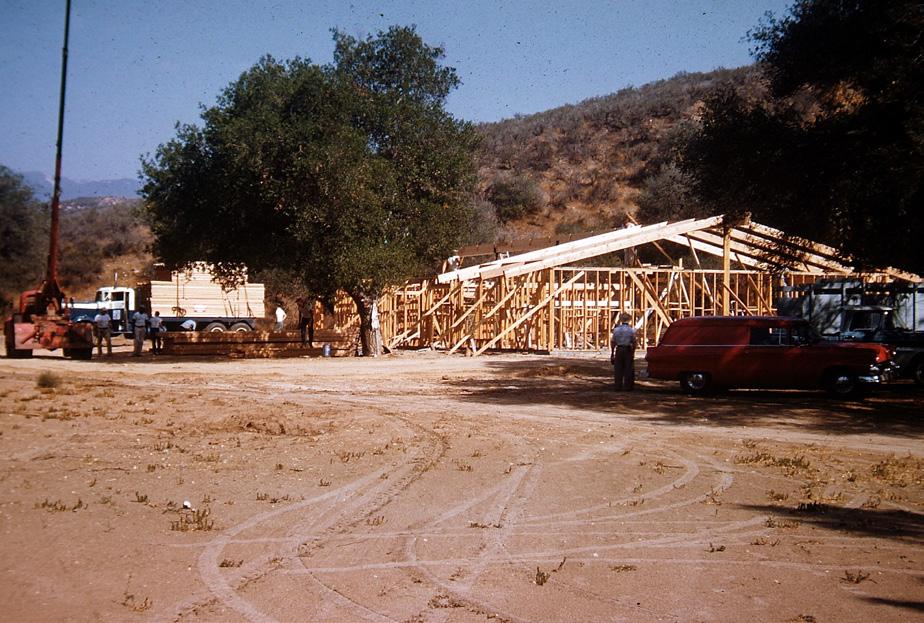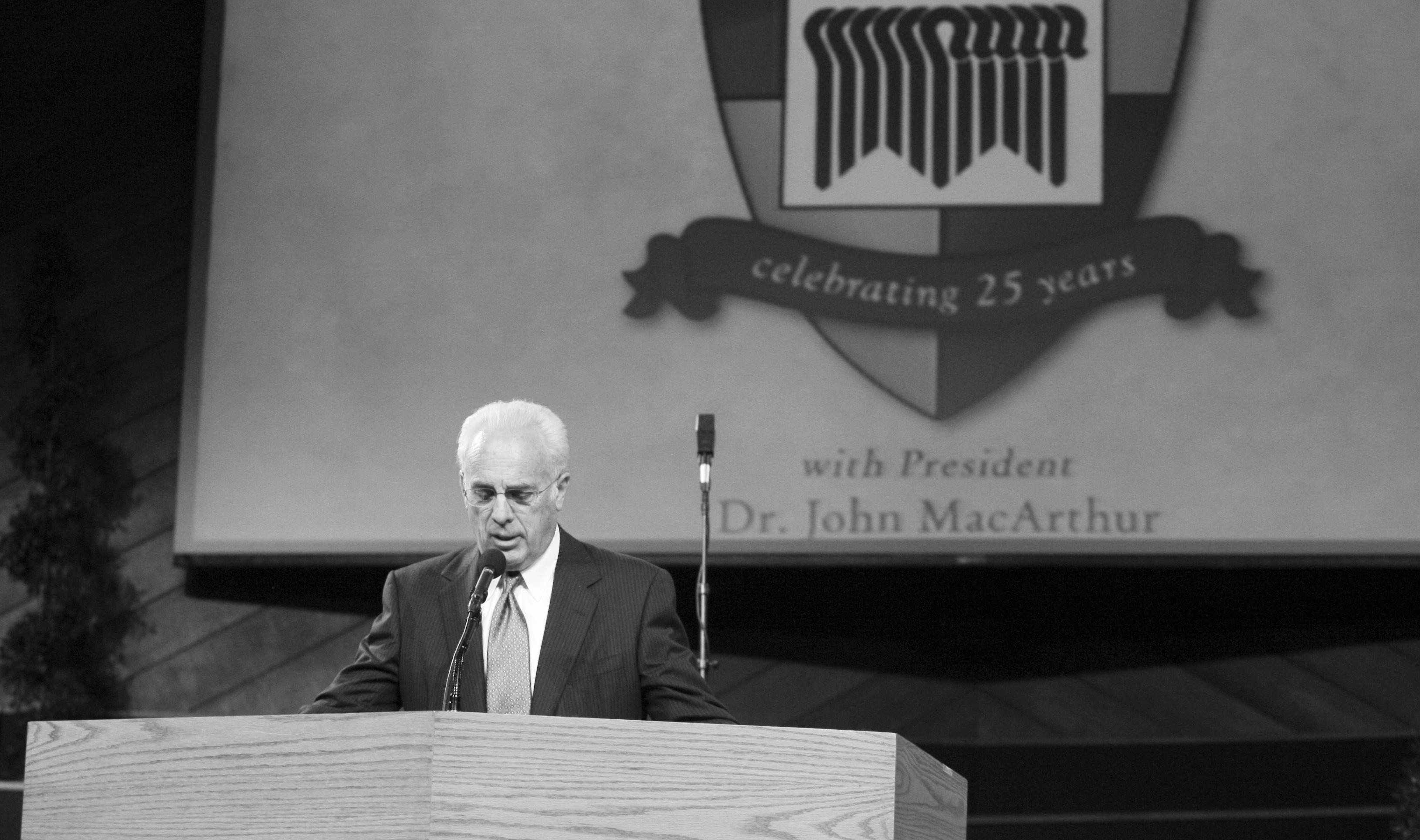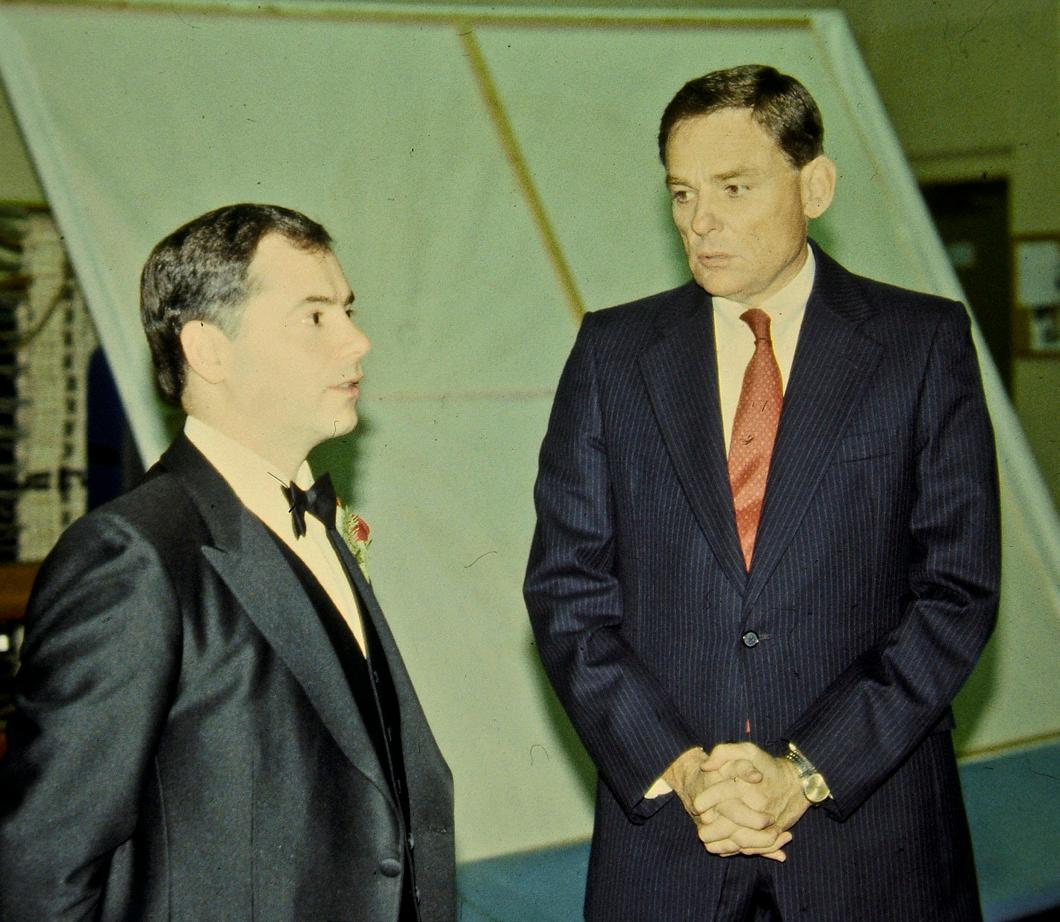
16 minute read
The Move to Newhall
CAMPUS IN 1962. YOU CAN SEE THE
POOL – LOCATED IN THE SAME SPOT
IT IS TODAY – NEAR THE PHOTO’S
BOTTOM-LEFT CORNER.
EDITOR’S NOTE
After years of leadership turnover and hard struggle, a stabilizing force arrived in 1959: Dr. John R. Dunkin. The school had been in existence for 32 years when Dunkin was named president, and he served in the role for the next 26. One challenge the school faced at the time was finding a location that would allow it to grow. Back then, it was located on 1/3 of an acre in Boyle Heights, a neighborhood in East Los Angeles. The school had considerable debt and no funds to purchase property. However, that didn’t keep people like Dunkin from praying that the Lord would provide. Dunkin recounts the way in which the Lord answered these prayers in a sermon he preached in 1993, “The History of The Master’s College.” Dunkin starts by telling how he came to hear of 27 acres in Newhall, California. This plot of land – which once served as Happy Jack’s Dude Ranch – now makes up a portion of TMU’s 95-acre campus.
DUNKIN
One day, a dear brother phoned me and he said, “We've got it. It's in Newhall.” I said, “Where is that?” He began to describe it. I shared it with the other members of the board, and they didn't know where it was for the most part. But at any rate, eventually we came out and looked at it.
After looking at it, we went up to what is now Cal Islands. It was Tip’s restaurant back then. And we met there and we said, “Well now, how shall we proceed? … How would it be if we pass around a sheet of paper, and each one of us will write down the most money we believe we could raise to buy the campus?” So we sat there and we pondered, and the paper went around and came back with a total of $9,000 that we thought we could raise. The number was far short of what would be needed. One of the men leaned over to me and said, “Doc, I guess that's it.” We all sat there sort of stunned. And finally Dr. Irving Penberthy, a board member, said, “I don't think this is right. I think we ought to go ahead.” Another man said, “So you mean, in spite of the fact that we've only dreamed up $9,000 – we don't have $9,000, we're just thinking that we might be able to reach a total of $9,000.” “No,” Dr. Penberthy said. “I
believe that if God is in it and has brought us this far, we ought to go ahead.”
And you know, within five minutes, we're all saying the same thing. We sang the doxology, walked out of there without a dime, and went on back to negotiate.
EDITOR’S NOTE
As word got around that LABTS had found a prospective new home, letters of congratulations poured in. But Dr. Dunkin made clear that in order to secure the 27-acre property, it would take more than kind words. Dr. Dunkin wrote: “Special gifts from many, many churches are needed. We appreciate congratulations – but they do not build great Baptist Testimonies. We enjoy admiration – but it never educated a young Christian. We understand apologies – but they never win souls for Christ. A need is a condition which is either improved or it passes beyond recovery.” Dr. Sweazy picks up the story from there.
SWEAZY
Space in this limited account forbids mention of many types of heroic servants and service which well deserve recognition. As the most startling costs were announced, individuals and churches gave sacrificially of time and money to make the new location a reality in time for the opening of school at the new location in September 1961.
For the first time in the history of our churches of Southern California a unifying challenge brought a measure of cooperation never before known. Indeed, God had wrought a miracle and continued to do so during pressing days of construction.
From May 1961, when the main portion of the new campus in Newhall was occupied, even until the present day, from one crucial situation after another, through prayer and consecration, to victory after victory, the progress of the Los Angeles Baptist College has been a continual testimony that God honors faith, dedication and sacrifice.
The Robert L. Powell Chapel-Library was the first new building completed, and on Labor Day of 1961 over 500 people picnicked at the campus for its formal dedication. As the keynote of the program, Dr. Penberthy preached on the school motto: “For the Word of God and the Testimony of Jesus Christ.”
Many types of specialized volunteer services were given for this building, as well as for the construction of the dining hall and administration building, supervised by Mr. Henry Vider. The “White House” (now called the Chancellor’s House) was completed in April 1962 and Dr. Dunkin soon moved his charming wife and six children into it.
In February of 1965, the much needed Hotchkiss Hall dormitory was ready for occupancy and dedication. No man ever deserved to be memorialized in connection with an educational institution more than Herbert Hotchkiss.
DR. JOHN DUNKIN’S ARRIVAL IN 1959 WAS A CRUCIAL TURNING POINT IN THE HISTORY OF LOS ANGELES BAPTIST COLLEGE. UNDER DUNKIN’S LEADERSHIP, THE SCHOOL ENJOYED A SEASON OF UNPRECEDENTED GROWTH. CONSTRUCTION OF THE ROBERT L. POWELL LIBRARY IN 1961.


PORTIONS OF THIS STORY WERE ADAPTED FROM DR. CARL SWEAZY’S BOOK “THE FIRST FIFTY YEARS OF L.A.B.C. 1927-1977” AND A SERMON DR. JOHN DUNKIN PREACHED IN 1993 TITLED, “HISTORY OF THE MASTER’S COLLEGE.”
A NEW President AND A NEW NAME

EDITOR’S NOTE
In 1985, Dr. John MacArthur became president of Los Angeles Baptist College, which that same year changed its name to The Master’s College. MacArthur’s arrival brought with it great excitement among the staff, student body and faculty. The move also drew attention from outside the campus, helping bring many new students to Placerita Canyon over the ensuing years. In 2010, MacArthur wrote an article for The Master’s Current, the school’s magazine at the time, reflecting on his first 25 years as president.
MACARTHUR
“I thank Him who has given me strength, Christ Jesus our Lord, because He judged me faithful, and appointed me to His service…” 1 Timothy 1:12
When I was first asked to be president of Los Angeles Baptist College, Christian education was already one of my passions. I knew there was a great need in Southern California for a sound, biblical college. LABC had tremendous potential; I had taught there several times and was well-acquainted with Dr. Dunkin and other faculty members. As time passed, my burden for the
college grew heavier and heavier. In 1985, I agreed to become its president.
Those of us on the leadership team recognized the great opportunity that we had before us – to mobilize students for Kingdom impact, building upon a legacy of ministry carried out by the faithful men and women who started the school. We determined, by God’s power, to see that the education we provided would rest on the solid foundation of the past. We wanted to create a place where serious young believers could come and be trained to make an impact for Christ in their nation and in the world.
My original vision for the college was twofold: first, I wanted our Christian education to be about truth applied in all spheres of life. Second, I wanted it to be about profound spiritual unity, bringing together the diverse members of our campus into one body for Christ. The Lord has been faithful to help us carry out both of these visions, and I am privileged to share with you the details of how The Master’s College – as you know it today – came about.
When it was established in 1927, Los Angeles Baptist College was intended to be a fundamentalist school of the prophets. Born in a period when liberal theology was sweeping across the country, LABC developed into a training ground for the gospel in protest against rationalism and modern unbelief. Indeed, the lure of academic prestige had been successful in ensnaring many well-known theological seminaries – and LABC was to be different.
I also understood that in order to fight the academic tendencies of the day, we would have to strive to apply biblical truth in all disciplines. In order to accomplish this goal, two things had to happen: first, the college needed to focus not only on Bible training, but also on a well-rounded liberal arts education; second, the name needed to change so that what we were building would be bigger and broader than the school’s past. In establishing The Master’s College as a fully accredited liberal arts institution, we understood that we were undertaking a serious responsibility to mold the diverse gifts of each student.
Both Luther and Calvin believed that vocation was not reduced to work in the church, but rather that it was a heartfelt calling of God manifested in talents, gifts, and desires. We embraced their vision and developed a vocational liberal arts education: in other words, an education preparing young people to infiltrate every part of society with solid biblical truth. We wanted to begin something that would impact the world for the Master. The college truly became the Master’s tool – The Master’s College. When we submitted that name to the board and the student body in 1985, it was unanimously accepted. Students and faculty members alike grew excited for the challenges ahead.
Twenty-five years later, we can see the fruit of faithful

THE SCHOOL CHANGED ITS NAME IN 1985 FROM LOS ANGELES BAPTIST COLLEGE TO THE MASTER’S COLLEGE, SO IT COULD BETTER COMMUNICATE ITS COMMITMENT TO THE LORDSHIP OF CHRIST AND BROADEN THE SCHOOL’S CONSTITUENCY.
labor. The academic character and quality of this institution have far exceeded what anybody thought would ever happen here. God has kept His promise to bless those who remain faithful to His Word: TMC has become an elite institution without giving in to arrogance, but rather by just clinging to the truth of the gospel. How is it that in a world where broadmindedness, tolerance, and academic freedoms are prized that The Master’s College, with all of its narrow convictions, is so highly honored? I’ll tell you how – God.
My good friend Dr. John Stead often jokes that a college faculty is a group of people loosely held together by a common parking lot. At TMC, I wanted much more than that. To market the school, we needed a premier faculty. In the early years, whether or not we had the funds, I hired anybody who understood and showed interest in our vision for the school. These people, spread out across a variety of disciplines, needed to come together under a common belief. I needed to find people who understood the core truths of Scripture, so the doctrinal statement was born. I knew that if I could find people who would agree with all 14 pages of that document, we would have a school committed not only to academic excellence but also to spiritual dynamism. We would have spiritual unity, something I wanted for our students as well. In fact, that was the most important vision I brought to the table. We needed to develop strong spiritual leadership and discipleship in our students. My mission was for the Christian people living here to treasure the opportunity to worship and fellowship together in a way that brings glory to our Savior.
Chapel, a unique TMC experience, would further implement this unity. Indeed, our chapel program has become the cornerstone of our commitment to shepherd the young men and women God sends to us. Students go to chapel and set aside the pressures of college life and refocus everything on Christ. Three times a week, they worship together side-by-side with roommates, classmates, and professors. On uncounted occasions through the years, it has been my privilege to stand behind the chapel pulpit. I treasure those opportunities, because I understand how important it is to equip our students to glorify Christ. We must continually be inclining our thoughts and hearts toward God. While that certainly occurs in the classroom, chapel is the one place where it happens corporately and exclusively. For the same reason, I encourage families of students and prospective students to attend chapel services. More than any stop on a campus tour, an hour worshiping with the rest
THE INTERNATIONAL REPUTATION OF DR. MACARTHUR AS A BIBLE TEACHER RESULTED IN RAPID STUDENT BODY GROWTH AFTER HIS ARRIVAL IN 1985.


DR. MACARTHUR SAYS ONE DISTINCTIVE CHARACTERISTIC OF THE SCHOOL IS THAT STUDENTS’ RELATIONSHIPS WITH FACULTY MEMBERS – LIKE DR. PAUL PLEW, LEFT, AND DR. JOHN STEAD, PICTURED HERE IN THE LATE 1980S – ARE NOT SIMPLY BASED ON ACADEMIC INQUIRIES, BUT ON DISCIPLESHIP. DR. MACARTHUR IN 1985.
of the Master’s community will reveal our heartbeat. Today, you can talk to any student on The Master’s College campus and you will see how God has allowed our desires for the school to become realities. These young men and women refer to chapel as the heart and soul of the school. But our vision doesn’t stop there. Their relationships with the faculty members are not simply based on academic inquiries, but on discipleship. Commitment to foreign missions flavors TMC with everything from a strong community of international students to summer trips overseas. Our extension campus in Israel, IBEX, allows students to experience the Scriptures uniquely. All of these things have come together over the past 25 years, and we are more excited about the future of this institution than ever.
Our Lord only ever built one institution – the church. He didn’t build a Christian college. The Master’s College will never be a substitute for the universal body of Jesus Christ. But from its very beginning, the college has been training men and women to love the gospel so that they can go out and be effective members of that body. I consider myself blessed and privileged to work alongside each and every person at The Master’s College. In 1985 I said, “It is with a sense of fear mixed with tremendous anticipation that we move ahead to see what God will do in the days, weeks, months, and years that will make up the future life of The Master’s College until Jesus Christ comes again. And until He comes, it’s our goal that we should be able to perfect the saints for the work of the ministry, for the building up of the body of Christ. That noble task must, to be accomplished, be energized by the spirit of God, and to that end we pray.” Those words are still true today – and all the glory goes to God who has been faithful to us in this endeavor.
When I first came, I agreed to be president for five years. I’m not sure where the other 20 have gone. As for today and tomorrow, I sincerely pray for the opportunity to see this college become an even greater beacon of light to a dying world, for the glory of God and the equipping of the saints.

THIS STORY WAS ADAPTED FROM AN ARTICLE THAT ORIGINALLY APPEARED IN A 2010 EDITION OF THE MASTER’S CURRENT.
FROM THE DESK of DR. ABNER CHOU A RESPONSE TO DR. MATTHEWS’ LETTER FROM 1928.
In 1928, Dr. William Matthews, the first president of Los Angeles Baptist Theological Seminary (now The Master’s University and Seminary), wrote his reflections upon the first year of the institution’s history. He expresses his joy over what the Lord had done in the life of the school as well as the critical need for sound theological education. But he also asks a question. To use his words, “Since the Seminary stands forsquare [sic] for the Fundamentals, may we not expect that all true Baptist Fundamentalists everywhere will be interested in its future?” In the context of the letter, Matthews, though noting the school had a wonderful first year, wonders if the institution would continue. Would there be people who would stand for theological fidelity in years to come?

Upon contemplating what he wrote all those years ago, here would be my answer from one president to another:
SO OUR FIRST PRESIDENT ASKED A QUESTION, AND
IT FALLS TO ALL OF US—PRESIDENT, BOARD, FACULTY,
STAFF, DONOR, STUDENT—TO RIGHTLY ANSWER IT.
THE PAST DRIVES AND DETERMINES OUR FIGHT FOR
THE FUTURE. THOUGH TIME MAY PASS AND THINGS
MAY CHANGE, THE WORD OF GOD NEVER CHANGES
AND SO OUR MISSION MUST NEVER CHANGE AS WELL.
MAY IT BE THAT ON THE EVIL DAY, HAVING DONE EVERYTHING, THAT WE STAND FIRM (CF. EPH 6:13).
Dear Dr. Matthews, Years ago you pondered if there would be those interested in the future of Los Angeles Baptist Theological Seminary. Would there be those who would support the institution financially, send students, and most importantly, share in its convictions and uphold them? Since the time you have written, many generations have come and gone. Even so, now in our 95th year, we can still affirm with our whole heart that we did not shrink back from declaring the whole purpose of God (cf. Acts 20:27). As you so eloquently expressed, we still do not “deny the authority of God’s Word.” We maintain to this day the inspiration, inerrancy, sufficiency, and supremacy of Scripture without reservation. We still do not “exalt reason and science over revelation.” Our stance on creation remains unchanged. We still do not “deify the intellectual and dethrone the spiritual.” We remain convinced that Christ must be Lord over all things and that there is no divide between the sacred and secular, all must be for His glory (cf. 1 Cor 10:31). And many have given, sent students, written, taught, sacrificed, invested, and led so that this institution continues “as a champion to defend the faith delivered once for all time to the saints; as a garrison to keep that which God committed to the churches; as a shepherd to feed and watch over the under-shepherds of the flock of God.” On each and every point you mentioned, our entire campus has not wavered but remains resolute so that just as generations before us, we may continue to raise leaders to shepherd the people of God and send the saints to fortify the church as the pillar and grounds of the truth. It is an honor to walk in the footsteps of faithful men. Your letter is a reminder that our convictions are not a fabrication of our time, but rather reflect the heart of the godly of all time. You sacrificially labored to begin an institution that would carry on the work to entrust the truth “to faithful men who will be able to teach others also” (2 Tim 2:2). Now in the plan and providence of God, it is our turn to carry this out. And by God’s grace, our goal is to use every resource and opportunity to not only be faithful but also to pave the way for all generations after us to be faithful till our Lord returns.

